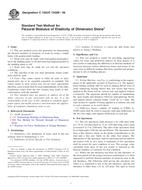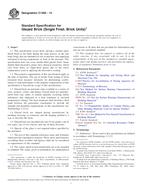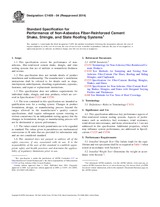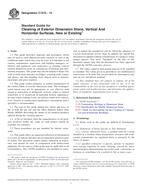Potrebujeme váš súhlas na využitie jednotlivých dát, aby sa vám okrem iného mohli ukazovať informácie týkajúce sa vašich záujmov. Súhlas udelíte kliknutím na tlačidlo „OK“.
ASTM D6910/D6910M-09
Standard Test Method for Marsh Funnel Viscosity of Clay Construction Slurries (Withdrawn 2018)
Automaticky preložený názov:
Štandardná skúšobná metóda pre Marsh Lievik Viskozita ílové výstavbe kašou
NORMA vydaná dňa 1.10.2009
Informácie o norme:
Označenie normy: ASTM D6910/D6910M-09
Poznámka: NEPLATNÁ
Dátum vydania normy: 1.10.2009
Kód tovaru: NS-36972
Počet strán: 3
Približná hmotnosť: 9 g (0.02 libier)
Krajina: Americká technická norma
Kategória: Technické normy ASTM
Kategórie - podobné normy:
Minerální stavební materiály a produkty
Měření objemu, hmotnosti, hustoty, viskozity
Anotácia textu normy ASTM D6910/D6910M-09 :
Keywords:
bentonite slurry, clay slurry, funnel viscosity, hydraulic barriers, marsh funnel, slurry, viscosity, Clay products (general), Drilling (in soil/rock), Marsh funnel viscisity, Slurries, Slurry wallviscosity, Soil stabilization, Viscosity--clay materials/applications, ICS Number Code 17.060 (Measurement of volume, mass, density, viscosity), 91.100.15 (Mineral materials and products)
Doplňujúce informácie
| Significance and Use | ||||||
|
This test method allows for the assessment of an apparent viscosity of clay slurries in the laboratory and in the field. Viscosity is a fundamental characteristic for slurries in construction applications. The Marsh Funnel Viscosity test can be used for field quality control of slurries. Relative changes in slurry viscosity can be identified using Marsh Funnel measurements and modifications can be made to mixing and handling procedures. In this test, it is assumed that the apparent viscosity of a slurry is directly related to the flow duration through a specially shaped funnel (the Marsh Funnel). Note 1—The development of the Marsh Funnel is credited to Hallan N. Marsh of Los Angeles who published the design and use of his funnel viscometer in 1931. In slurry wall construction and other applications, the viscosity of a slurry must be maintained at a level high enough to assist in stabilizing the trench walls. Slurry viscosity is also directly related to filter cake permeability. The Marsh Funnel Viscosity has been widely used in drilling soil and rock for water wells, oil, gas, soil stabilization, and the application of hydraulic barriers. Inert suspended solids such as fine sands and additives affect the viscosity of slurries. This test may be used to determine the relative effects of this and other such materials on the viscosity of a slurry. Note 2—The quality of the result produced by this standard is dependent on the competence of the personnel performing it, and the suitability of the equipment and facilities used. Agencies that meet the criteria of Practice D3740 are generally considered capable of competent and objective testing, sampling/inspection/etc. Users of this standard are cautioned that compliance with Practice D3740 does not in itself assure reliable results. Reliable results depend on many factors; Practice D3740 provides a means of evaluating some of those factors. |
||||||
| 1. Scope | ||||||
|
1.1 This test method provides an indirect measurement of the viscosity of clay slurries using a funnel (Marsh Funnel) and a graduated cup of specific dimensions. This test method provides a practical indicator of the viscosity on a routine basis. This test method has been modified from the API Recommended Practice 13B-2. 1.2 The result determined using the method is referred to as the Marsh Funnel Viscosity. 1.3 This test can be performed in the laboratory, or used in the field to assess the apparent viscosity of a clay slurry for quality control purposes. The most commonly used slurry is a bentonite clay slurry. 1.4 The values stated in either SI units or inch-pound units [given in brackets] are to be regarded separately as standard. The values stated in each system may not be exact equivalents; therefore, each system shall be used independently of the other. Combining values from the two systems may result in non-conformance with the standard. 1.5 This standard does not purport to address all of the safety concerns, if any, associated with its use. It is the responsibility of the user of this standard to establish appropriate safety and health practices and determine the applicability of regulatory limitations prior to use. |
||||||
| 2. Referenced Documents | ||||||
|
Podobné normy:
Historická
1.11.2006
Historická
1.11.2011
Historická
1.4.2009
Historická
1.2.2014
Historická
1.6.2014
Historická
1.1.2014
Odporúčame:
EviZak - všetky zákony vrátane ich evidencie na jednom mieste
Poskytovanie aktuálnych informácií o legislatívnych predpisoch vyhlásených v Zbierke zákonov od roku 1945.
Aktualizácia 2x v mesiaci !
Chcete vedieť viac informácii ? Pozrite sa na túto stránku.



 ASTM C1252-06
ASTM C1252-06 ASTM C1283-11
ASTM C1283-11 ASTM C1352/C1352M-09..
ASTM C1352/C1352M-09.. ASTM C1405-14
ASTM C1405-14 ASTM C1459-04(2014)..
ASTM C1459-04(2014).. ASTM C1515-14
ASTM C1515-14
 Cookies
Cookies
